november  2009
2009
 Last Wednesday night I went to see Amy Goodman at the Downtown Library where she was speaking as part of a book tour for her collection of articles entitled Breaking the Sound Barrier. I arrived at the Alice McKay meeting room on the basement level at 6:30 to buy a ticket and took my place behind a small group of people. Just a few minutes later, a line had formed behind me that extended all the way up the stairs to the main entrance and beyond. The crowd was a congenial, all-ages mix of liberal-intellectual types, many of whom were taking the opportunity to distribute their own materials, promoting their radio stations, zines and poetry. There were even representatives from Vancouver's own 9-11 Truth society (who knew we had one?) handing out flyers and DVDs of an Italian documentary, which I watched when I got home; it was in English and the production was actually pretty good.
Last Wednesday night I went to see Amy Goodman at the Downtown Library where she was speaking as part of a book tour for her collection of articles entitled Breaking the Sound Barrier. I arrived at the Alice McKay meeting room on the basement level at 6:30 to buy a ticket and took my place behind a small group of people. Just a few minutes later, a line had formed behind me that extended all the way up the stairs to the main entrance and beyond. The crowd was a congenial, all-ages mix of liberal-intellectual types, many of whom were taking the opportunity to distribute their own materials, promoting their radio stations, zines and poetry. There were even representatives from Vancouver's own 9-11 Truth society (who knew we had one?) handing out flyers and DVDs of an Italian documentary, which I watched when I got home; it was in English and the production was actually pretty good.
 The doors opened a few minutes before seven and we were allowed into the large meeting room; I found a seat in the back row, right on the aisle and watched the room fill up. At one point, a group of four took their seats in the row in front of me and one of them looked so familiar but I couldn't place him at first. For a second I thought, "oh my god, is that Reverend Billy?" Then I realized it was Marc Emery with his lovely wife and friends. I later found out that he was temporarily released on bail on November 18 while he waits for the Justice Minister to sign his extradition papers. In this podcast recorded a few days before his release, he talks about his history of philanthropic support for medical marijuana and drug law reform as well as the history of US and Canadian drug policy.
The doors opened a few minutes before seven and we were allowed into the large meeting room; I found a seat in the back row, right on the aisle and watched the room fill up. At one point, a group of four took their seats in the row in front of me and one of them looked so familiar but I couldn't place him at first. For a second I thought, "oh my god, is that Reverend Billy?" Then I realized it was Marc Emery with his lovely wife and friends. I later found out that he was temporarily released on bail on November 18 while he waits for the Justice Minister to sign his extradition papers. In this podcast recorded a few days before his release, he talks about his history of philanthropic support for medical marijuana and drug law reform as well as the history of US and Canadian drug policy.
Anyway, the meeting room was full by the time this adorable older gentleman named Mordechai took the podium and announced that Amy Goodman had been detained at the border and was on her way but would still be another hour. He told us that the border guards were very concerned about whether she was planning on talking about the Olympics — this revelation was met with groans from the audience — he then urged us to go get a coffee or some dinner and come back at eight.
I returned in an hour and eventually it seemed that everyone and more returned to take their seats and even to line the walls and the back of the room behind the last row where I was sitting. Amy Goodman spoke for 90 minutes, beginning with the story of her interrogation at the border, the first of many repetitions which would be picked up the next day by mainstream Canadian news outlets like The Globe & Mail and The Toronto Star, in addition to the in dependant media outlets in attendance that night. The story was covered by CBC News — in fact, it was the top video story on CBC's web site Thursday — and Amy talked about it today on Democracy Now, the first episode since her return to the safety of her New York studio. You can hear the speech she gave at the library in its entirety on rabble.ca's Radio Book Lounge.
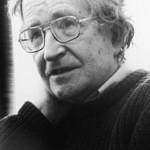 She talked about healthcare reform in the US and the upcoming conference on global warming in Copenhagen, which Obama had just that day announced he would attend. She also talked a great deal about her mother who died last month, which brought me and at least a few other members of the audience to tears. Describing the household in which she grew up, she mentioned that her parents had been lifelong friends of Noam Chomsky, whose wife also died last December, and that the Chomskys had known each other since they were two years old. Aside from quoting the border guards, she did not talk about the Olympics ("As people who know me know, I'm not a real sports fan!") but she said the experience at the border had certainly piqued her interest to look into it further. On today's show, she interviewed two activists from BC about the Olympics and the great lengths and expense to which the province is going to silence its critics.
She talked about healthcare reform in the US and the upcoming conference on global warming in Copenhagen, which Obama had just that day announced he would attend. She also talked a great deal about her mother who died last month, which brought me and at least a few other members of the audience to tears. Describing the household in which she grew up, she mentioned that her parents had been lifelong friends of Noam Chomsky, whose wife also died last December, and that the Chomskys had known each other since they were two years old. Aside from quoting the border guards, she did not talk about the Olympics ("As people who know me know, I'm not a real sports fan!") but she said the experience at the border had certainly piqued her interest to look into it further. On today's show, she interviewed two activists from BC about the Olympics and the great lengths and expense to which the province is going to silence its critics.
So it was an exciting evening and I've been following the border story with great interest ever since. It seems "clean up the homeless" legislation and the banning of signs criticizing the Olympics were only the tip of the iceberg.
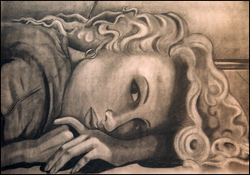 There's always this weird moment when someone I've known for a while comes over to the apartment for the first time. It usually takes them about two steps into the living room or, if they pause in the entryway to fumble with their footwear, a glance to the left or right, before they spot one of the framed charcoal drawings on the wall. Yes, they're mine... I did them in college. No, I haven't done any recently. How recently? Well... since these.
There's always this weird moment when someone I've known for a while comes over to the apartment for the first time. It usually takes them about two steps into the living room or, if they pause in the entryway to fumble with their footwear, a glance to the left or right, before they spot one of the framed charcoal drawings on the wall. Yes, they're mine... I did them in college. No, I haven't done any recently. How recently? Well... since these.
They might have been vaguely aware that I studied art in college (or university, as they say here) but usually it's never come up in conversation. There's this moment of reaction and reassessment — sometimes brief, as in, "oh that's right... Where is Baltimore again?" Once in a while, I get a reaction that's way out of proportion, like I've somehow betrayed them by harboring this hidden talent and not telling them — and worse, not making use of it.
"Oh my god, why don't you draw anymore?" In the conversation that follows, I explain that I grew up drawing and, although it's a skill and a craft that I'm grateful to have, it's not really a calling. What skill I do have, frankly, isn't enough to make a career out of. I've never thought to say this but it would be like me going to someone's house for dinner and raving about their cooking, then demanding to know why they're not a professional chef.
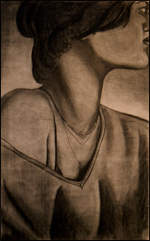 "This salmon is amazing... You know, you could open your own restaurant... No, I'm serious... Sure, I guess there are a lot of restaurants that serve salmon but — well, it just seems like such a waste of your talents..."
"This salmon is amazing... You know, you could open your own restaurant... No, I'm serious... Sure, I guess there are a lot of restaurants that serve salmon but — well, it just seems like such a waste of your talents..."
Okay, I know... Bitch, bitch, bitch. I do love that people are impressed and I admit it's weird to have all these things around but never talk about them. It's a strange, disconnected piece of my life about which there is visible evidence all around — unlike, say, a previous marriage or cocktail waitressing jobs. Until recently I hardly ever thought about actually drawing again because everything about the technique and setting that produced most of my favorite pieces made the whole thing seem like such a complicated production.
First, there's the unholy and unavoidable mess of working with charcoal — clouds of dust in the air, ground into the carpet, under your nails and in all the previously invisible cracks and creases in your skin — and it's not like I have a deadline to force me to finish what I've started by the following morning. I can just see myself digging through boxes of decade-plus-old art supplies down in my storage locker, bringing them upstairs where I'll have to put them to use immediately, since there's no shelf space available for anything new; setting up in an empty corner of the apartment — which doesn't actually exist — with enough space to spread out a board and paper; dust cloths, three different weights of charcoal, erasers and sharpeners and something within reach to collect pencil shavings (so important yet so easy to forget).
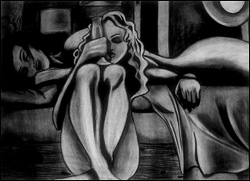 Once I've arranged this mythical spot, which for logistical reasons has to be on the floor, somehow made comfortable enough to sit for several hours without risking paralysis, I will proceed to give myself carpel tunnel syndrome and seriously flirt with black lung covering the entire page with a layer of loose charcoal to achieve a perfect base of 30% grey. All of this will have taken two to three hours, by which time I will be utterly exhausted, not to mention totally devoid of any idea what to draw, so I will give up for the night, weakly promising to finish the next day but more likely dismantling the whole sorry attempt several weeks later when seeing it and stepping over it every day finally becomes too much to bear.
Once I've arranged this mythical spot, which for logistical reasons has to be on the floor, somehow made comfortable enough to sit for several hours without risking paralysis, I will proceed to give myself carpel tunnel syndrome and seriously flirt with black lung covering the entire page with a layer of loose charcoal to achieve a perfect base of 30% grey. All of this will have taken two to three hours, by which time I will be utterly exhausted, not to mention totally devoid of any idea what to draw, so I will give up for the night, weakly promising to finish the next day but more likely dismantling the whole sorry attempt several weeks later when seeing it and stepping over it every day finally becomes too much to bear.
Most of the pieces I have up on the walls are 30"x40", which is big. Our drawing professor was adamant that we use the largest sheets of Rives BFK, the most expensive paper available at the art supply store. They were a huge pain in the ass for someone my size to carry; a big enough portfolio, even with well-placed handles, is a monster to transport. The one I used was stiff enough to double as a drawing board but it definitely did not have "well-placed handles." I eventually bought a softshell case, the largest in stock, to house my entire college career's worth of drawing, design and illustration assignments.
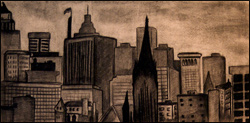 Drawing class was every Friday from 8 to 4, a fact that my roommate and I always seemed to forget until Thursday night. Then we'd stake out opposite corners of the living room and set up a pair of adjustable-arm lamps to spotlight our workspaces, like two lizards facing off in a terrarium. We would carefully mask off the perimeter of our drawing boards with tape, leaving a 30"x40" space to fill by morning, and sit there drawing late into the night, sometimes singing along to CDs (Concrete Blonde, Sinead O'Connor, The Commitments). It took about 6-8 hours, sometimes more. The next day we'd pack up our huge portfolio cases and walk several blocks to class. The strings that held the portfolios closed would cut into our gloved fingers and we'd have to stop and switch hands a couple of times every block.
Drawing class was every Friday from 8 to 4, a fact that my roommate and I always seemed to forget until Thursday night. Then we'd stake out opposite corners of the living room and set up a pair of adjustable-arm lamps to spotlight our workspaces, like two lizards facing off in a terrarium. We would carefully mask off the perimeter of our drawing boards with tape, leaving a 30"x40" space to fill by morning, and sit there drawing late into the night, sometimes singing along to CDs (Concrete Blonde, Sinead O'Connor, The Commitments). It took about 6-8 hours, sometimes more. The next day we'd pack up our huge portfolio cases and walk several blocks to class. The strings that held the portfolios closed would cut into our gloved fingers and we'd have to stop and switch hands a couple of times every block.
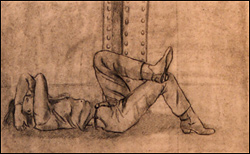 By the time we reached the refurbished factory building where our class was held, our fingers would be numb and we would have to stand by the big iron radiators lining the windows for 10 minutes before the circulation returned to normal. Then we'd carefully work the knots out of the strings to open our portfolios, tape our drawings up on the wall with everybody else's and take our seats on the cold concrete floor. We would spend the first hour of every class like that, with our coats spread out beneath us, for what our teachers called "critique" sessions, talking about each other's drawings.
By the time we reached the refurbished factory building where our class was held, our fingers would be numb and we would have to stand by the big iron radiators lining the windows for 10 minutes before the circulation returned to normal. Then we'd carefully work the knots out of the strings to open our portfolios, tape our drawings up on the wall with everybody else's and take our seats on the cold concrete floor. We would spend the first hour of every class like that, with our coats spread out beneath us, for what our teachers called "critique" sessions, talking about each other's drawings.
Critiques were moderated by our professors but only loosely, and we were all encouraged to speak up and point out things that "worked," what we liked or didn't like. If we were reticent, the professor would goad us by standing in front of one drawing or another saying "so, what do we think of this?" The critiques had no effect on our grades; it was more like a way of desensitizing us to criticism — which seemed somewhat redundant to a class of 18-year olds who had just convinced their parents to spend $25K a year on art school — but it was also intended to help us improve, to the extent that we valued the opinions of our classmates.
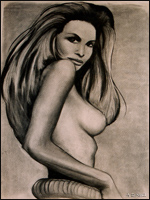 Critiques got more interesting for me as the assignments became less and less so; for the first half of the year, we were mired in "still life" hell as our professor urged us to create compositions that demonstrated principles like variations in texture, contrasting depths of field, chiaroscuro and squeezed intervals — interesting spaces — between objects. I hated still lifes so I tried to work human figures into all my assignments, which often resulted in my professor standing in front of them, shaking his head and smiling, "so, what do we think of the technique — please, not the content — of this?" This is the same guy who would later propose, once we entered the "life" drawing phase of the class, that we think about the human body as a still life; "Arnold Schwarzenegger's deltoids — they're like huge, ripe cantaloupes." The rest of the class giggled but I was already way ahead of him. I'd been buying bodybuilding magazines to draw from for years (along with Playboy) because you won't find a better anatomy resource that shows you all the underlying muscle structures, but with the skin still on.
Critiques got more interesting for me as the assignments became less and less so; for the first half of the year, we were mired in "still life" hell as our professor urged us to create compositions that demonstrated principles like variations in texture, contrasting depths of field, chiaroscuro and squeezed intervals — interesting spaces — between objects. I hated still lifes so I tried to work human figures into all my assignments, which often resulted in my professor standing in front of them, shaking his head and smiling, "so, what do we think of the technique — please, not the content — of this?" This is the same guy who would later propose, once we entered the "life" drawing phase of the class, that we think about the human body as a still life; "Arnold Schwarzenegger's deltoids — they're like huge, ripe cantaloupes." The rest of the class giggled but I was already way ahead of him. I'd been buying bodybuilding magazines to draw from for years (along with Playboy) because you won't find a better anatomy resource that shows you all the underlying muscle structures, but with the skin still on.
 Then there were our self-portraits — seated, standing, line of sight perspective — but all nude. The way our professor pitched the assignments, it was his way of forcing us to get comfortable drawing bodies. Soon, all of our in-class sessions would involve nude models so, if we were going to be weird or squeamish or prudish or giggly about nudity, let's get it out of our systems now, before the models have to stand here in the cold for our benefit. I personally think that he was looking at a classroom full of teenagers from vastly different backgrounds, lifestyles and families, many demonstrably spoiled, and he just wanted to put us all on the same level, so that when the models came, we might be able to empathize with their nakedness.
Then there were our self-portraits — seated, standing, line of sight perspective — but all nude. The way our professor pitched the assignments, it was his way of forcing us to get comfortable drawing bodies. Soon, all of our in-class sessions would involve nude models so, if we were going to be weird or squeamish or prudish or giggly about nudity, let's get it out of our systems now, before the models have to stand here in the cold for our benefit. I personally think that he was looking at a classroom full of teenagers from vastly different backgrounds, lifestyles and families, many demonstrably spoiled, and he just wanted to put us all on the same level, so that when the models came, we might be able to empathize with their nakedness.
I saw no reason to let modesty stand in the way of actually completing an assignment so I chose an angle that allowed me to draw and pose at the same time, while exposing nothing more than you might see on television — for once, I was finished early and got a good night's sleep. Some of my classmates were completely unphased by the nudity, or at least they wanted to appear so; others experimented with black paper and white chalk or — expressionism. A few simply refused to do the assignments at all, betraying their complete lack of creativity as well as humor, while some others pretended not to care but evidently buckled once they found themselves alone and naked at the drawing board. The following week everyone filed into class and grudgingly taped their self-portraits up on the wall. Most of them were more psychologically than physically revealing; a lot of angry children scowled down at us from that wall in their shorts and t-shirts, their charcoal eyes like little black holes at the heart of a viciously cross-hatched darkness.
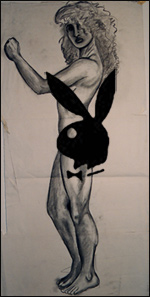 During this critique session we were unusually reserved, each of us surveying the others in varying states of nonchalance and humiliation. Just before the session ended, this little punk girl with blond hair like a 10-year old boy commented that mine looked "like something out of Playboy. No offense." A few people laughed nervously and I think I actually replied, channeling Corporal Hicks, "none taken." Our professor shot her a disapproving look before letting the class out for a break, then he came over and apologized and asked if I was offended. I couldn't decide if I was offended or felt sorry for her — mainly I felt like dragging her down a flight of stairs by her nose ring.
During this critique session we were unusually reserved, each of us surveying the others in varying states of nonchalance and humiliation. Just before the session ended, this little punk girl with blond hair like a 10-year old boy commented that mine looked "like something out of Playboy. No offense." A few people laughed nervously and I think I actually replied, channeling Corporal Hicks, "none taken." Our professor shot her a disapproving look before letting the class out for a break, then he came over and apologized and asked if I was offended. I couldn't decide if I was offended or felt sorry for her — mainly I felt like dragging her down a flight of stairs by her nose ring.
But that wasn't the worst thing I had heard in a critique; that would have been in my Elements of Design class. At the end of the day every Thursday we received our assignments and filed out of the room in that one state of mind our design professor reliably evoked in us — total bewilderment. We would usually wait until the following Monday evening when we all met in sculpture class to commiserate as a group and try to figure out what the hell she wanted from us. This time, the assignment was to enlarge a black and white picture of yourself on a photocopier until you couldn't see any recognizable features or details, just blobs and swirls of toner, then zoom in and crop until you found an area that, like, spoke to you.
The actual description from our professor's mouth had taken half a day of class time and probably included references to sociology and geometry — Euclidean and non-, possibly even sacred — and featured the works of Kandinsky and Klee, Egon Schiele and Frida Kahlo and some story about a backpacking trip she took through the Amazon jungle, traveling with a now-extinct tribe of painted warriors who taught her their ancient technique of self-portraiture involving lichen, Tapir dung and Ayahuasca.
Once you had zeroed in on the best part of the random patterns in all your xeroxed scraps of paper, you would meticulously transfer the outline onto a 5"x5" piece of illustration board and fill it in with ultra-matte, opaque black gouache, sort of a cross between paint and ink. We all did our damnedest and, in fact, the wall on Thursday morning displayed an amazing array of little Rorschach likenesses. We were rather impressed with ourselves, not least because it seemed, for once, that there was no way you could possibly fuck up this assignment. How wrong we were.
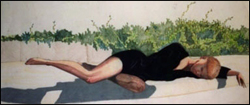 Our professor paced in front of the wall, leaning in to inspect one or straighten another, to grunt and squint approvingly or step back for a different perspective. Then she asked who wanted to go first. Blank stares. She swung around and pointed at us, sweeping her finger down the line. Off with their heads, I thought. "Do any of these images speak to you? Look at them. Is there a personality coming through? Describe it!" She started again from the other end with the pointing, looking like a villain in a melodrama sans the mustache. Then someone finally spoke up and she dropped her hands to her sides like a marionette. The speaker started describing a piece she liked, riffing on what she saw in its flat blackness — a whole character sketch of adjectives, traits and hobbies poured forth, sparking others to join in, calling out things like, "I see someone who's really carefree, extroverted and adventurous."
Our professor paced in front of the wall, leaning in to inspect one or straighten another, to grunt and squint approvingly or step back for a different perspective. Then she asked who wanted to go first. Blank stares. She swung around and pointed at us, sweeping her finger down the line. Off with their heads, I thought. "Do any of these images speak to you? Look at them. Is there a personality coming through? Describe it!" She started again from the other end with the pointing, looking like a villain in a melodrama sans the mustache. Then someone finally spoke up and she dropped her hands to her sides like a marionette. The speaker started describing a piece she liked, riffing on what she saw in its flat blackness — a whole character sketch of adjectives, traits and hobbies poured forth, sparking others to join in, calling out things like, "I see someone who's really carefree, extroverted and adventurous."
Finally, the professor asked whose piece it was and someone raised their hand — to gasps of amazement from the rest of us — of course this person was all those things, and our insights were clear evidence that she had aced the assignment, unwittingly capturing some ineffable fractal of herself and transmitting it to us in gouache. Our professor looked smug. ("See?") She urged The Carefree One to pick another piece and tell us about the person who made it. It went on like this for the rest of the morning. Every inkblot seemed to reveal amazing, eerie truths about its creator but the longer this went on, the more uneasy I became. I found myself staring at my little block of ink, its self-conscious abstractness conveying nothing about me, other than a vague squiggly section and a few spots in the middle that kind of reminded me of my hair and eyes. After enlarging, cutting up and taping scraps of photocopies together for two days I had become so annoyed with the pointlessness of the exercise, imagining that it could go on forever, as long as I kept rearranging the pieces without a clue what I was looking for. So, when I turned over a piece and saw that little fractal of me looking out from what had once been a nano-pixel of my eyebrow, I thought, that's it. Good enough.
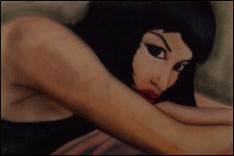 Only it wasn't. That was quickly becoming obvious. I tried to focus on one of the squares that hadn't been analyzed yet, to see if I could predict what everyone would say about it, but they seemed to be speeding up through the second half; besides, it was hard to concentrate with everyone shouting personality traits and the professor leaping around the room like a carnival barker.
Only it wasn't. That was quickly becoming obvious. I tried to focus on one of the squares that hadn't been analyzed yet, to see if I could predict what everyone would say about it, but they seemed to be speeding up through the second half; besides, it was hard to concentrate with everyone shouting personality traits and the professor leaping around the room like a carnival barker.
Then there were two inkblots left and the professor was standing in front of them, index fingers thrust towards them, Elvis-style. "Somebody — anybody — what do we see here?" Since we had gone with the musical chairs format, it stood to reason that the only people who hadn't spoken yet were somehow linked to those last two pieces. Finally someone said dryly, "I see a face in that one." Our professor pretended that she too had just noticed it. In reality, I had seen her looking at it twice already; she kept dodging around it, annoyed. Now she looked straight at it and stopped holding back. "Yeah, I see it too! In fact, I can't see anything else — I'm going to turn it upside down and see what happens." She did. The silence in the room was deafening. I prayed for a fire alarm — or an earthquake. She stared and stared at it, took a deep step backwards, then lunged forward (to discern the artist's intended proximity and thus the optimal viewing distance, a technique she claims to have practiced in the Louvre where the curators had hung a Rembrandt so low she was forced to sprawl on the floor to observe it from the intended angle).
Finally she tore into the person she imagined was to blame for this affront; this was a person "hiding behind a mask," who "feels like they're living in a fishbowl" and "keeps people at arm's length." The professor went on, "they've built a wall around themselves but now they're all alone." She was on a roll. "This person doesn't trust anyone... but is it because they've been hurt or because they themselves aren't trustworthy?" "They don't even know themselves," someone offered. More of my classmates chimed in; the person was shallow, manipulative, craved attention. The professor crouched until she was face to face with the inkblot. She squinted, then stood up abruptly. "All I know," she laughed, shaking her head. "is you only get as good as you give."
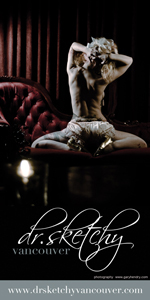 She looked around, finally snapping out of her trance, and announced that we were overdue for a break. Thank god. As everyone gathered up their coats and backpacks, the smokers gravitating towards the door in a mass, I ducked past them and out the door as quickly as possible. My head was spinning as the surrealness of what had just transpired began to sink in. My roommate caught up with me at the building's front door and we emerged into the bright cold Baltimore day. She gripped my shoulder with her mittened hand as if to say, "Wow, shitty." Yeah. That was pretty much the worst critique ever.
She looked around, finally snapping out of her trance, and announced that we were overdue for a break. Thank god. As everyone gathered up their coats and backpacks, the smokers gravitating towards the door in a mass, I ducked past them and out the door as quickly as possible. My head was spinning as the surrealness of what had just transpired began to sink in. My roommate caught up with me at the building's front door and we emerged into the bright cold Baltimore day. She gripped my shoulder with her mittened hand as if to say, "Wow, shitty." Yeah. That was pretty much the worst critique ever.
But anyway. I'm actually going to be drawing again soon. There's this thing called Dr. Sketchy's Anti-Art School that happens once a month and my friend thinks we should go. It's got almost everything it would take to counter my usual excuses for not wanting to do things like this. You can drink, you can talk, you can use any medium you want provided it doesn't produce fumes. Best of all, the models are a cabaret cast in outrageous costumes, guaranteed to inspire one's creativity.
A timely poll from the always hilarious and clever Mystic Medusa.
You know that saying "just enough information to be dangerous"? I wonder if anyone actually says this anymore. These days, we believe that any amount of information is a good thing, even if it comes from an unreliable source. That just means you should probably get a second opinion before treating it as fact. Of course, if you're too lazy to seek out corroborating evidence, or if you're a Gemini, you can always just insert a self-disclaiming caveat like "according to Fox News/Maxim/wikipedia..." Then again, how often does anyone really question you on those sketchy yet impressive-sounding statistics you throw into conversation? For that matter, when was the last time you challenged someone else's dodgy factoid mash-up with a skeptical "where did you hear that?"
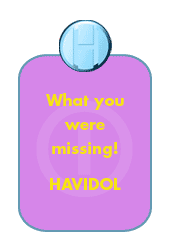 In the early days of the Internet, the traditional news media would frequently do these speculative scare pieces warning about the hazards of "e-hypochondria," or some other cute Internet-y phrase suggesting that people were being driven to hysteria by the glut of information that was suddenly available about every mental and physical malady known to science. What was once the exclusive pursuit of hardcore attention seekers with access to medical dictionaries would spread like a virus, subliminally seeding the ignorant masses with psychosomatic symptoms. (If only they could have foreseen the series House, in which every episode pitches a new crop of rare diseases, suggestive selling new and exotic afflictions to fuel the fantasies of the illness-junkies.)
In the early days of the Internet, the traditional news media would frequently do these speculative scare pieces warning about the hazards of "e-hypochondria," or some other cute Internet-y phrase suggesting that people were being driven to hysteria by the glut of information that was suddenly available about every mental and physical malady known to science. What was once the exclusive pursuit of hardcore attention seekers with access to medical dictionaries would spread like a virus, subliminally seeding the ignorant masses with psychosomatic symptoms. (If only they could have foreseen the series House, in which every episode pitches a new crop of rare diseases, suggestive selling new and exotic afflictions to fuel the fantasies of the illness-junkies.)
[Take the Self Assessment Test and find out if Havidol is right for you.]
Of course that was all before the regulations changed in 1997 making Direct-to-Consumer Marketing of pharmaceutical drugs not only legal but apparently necessary for that shining example of civilized healthcare they have in the US. Without TV commercials, how could men without email accounts have learned about Viagra? How could all those parents have figured out that what their troubled high school kids really needed wasn't parental role models but Paxil? I shudder to think of all those poor souls whose restless legs, social anxiety and premenstrual dysphoria could have gone undiagnosed indefinitely, causing untold suffering.
These days, "undiagnosed" isn't in our vocabulary. You have to be careful uttering random complaints about minor discomforts lest you awaken the latent diagnosticians among your friends and family. One minute you're blaming a recent sub-par performance or mood on some internal system dysfunction, the next minute everyone is free-associating with your symptoms and offering amateur medical advice.
WebMD is a good place to go if you want to quickly amass an impressive array of plausible causes for any ailment. Choose your gender, click the part of the body affected and check off specific symptoms to narrow the range between "tension headache" and "brain tumor." Advanced "e-hypochondriacs" can then move on to wrongdiagnosis.com to check out all the things they might actually have which their doctor (or WebMD) thinks is something else.
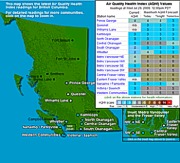 I figure why stop at — or for that matter, start with — physical symptoms? Unless it's actually a brain tumor, you know the end result will always come back to eat less, exercise more, go outside, laugh, spend time with friends and family instead of working too hard and obsessing in the dark by yourself hunched over a computer, drink more water and get more sleep, cut out stress, caffeine, sugar, processed food, factory farmed meat, frankencrops and corn derivatives.
I figure why stop at — or for that matter, start with — physical symptoms? Unless it's actually a brain tumor, you know the end result will always come back to eat less, exercise more, go outside, laugh, spend time with friends and family instead of working too hard and obsessing in the dark by yourself hunched over a computer, drink more water and get more sleep, cut out stress, caffeine, sugar, processed food, factory farmed meat, frankencrops and corn derivatives.
When I want to work myself into an information-fueled state of hysteria, I prefer to wallow in the minutiae of external factors; like how many cancer-causing agents the FDA has allowed the makers of my favorite moisturizer to poison me with. At the municipal and provincial levels, I can always obsess over BC's Air Quality Index or the chlorine levels in the City of Vancouver's Tap Water Sample Station Readings. (Which I actually do when my skin feels unusually dry for a few days in a row. Of course, sometimes the smell of bleach is so overwhelming that just standing over the sink is enough to make your eyes water — then I don't bother to seek out corroborating evidence.)
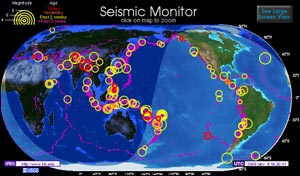 When I want to obsess locally while thinking globally, IRIS' World Seismic Monitor is just one of many online tools available. IRIS (Incorporated Research Institutions for Seismology) is an organization dedicated to compiling scientific data and publishing their findings for the benefit of sofa seismologists as well as legitimate professionals. The map is updated every 20 minutes to display current global seismic activity in near real-time, drawing data from monitoring stations all over the world. Every earthquake over a magnitude of 4.0 that occured within the last two weeks is rendered with yellow circles of varying sizes depending on the magnitude; the red circles indicate activity within the last 24 hours.
When I want to obsess locally while thinking globally, IRIS' World Seismic Monitor is just one of many online tools available. IRIS (Incorporated Research Institutions for Seismology) is an organization dedicated to compiling scientific data and publishing their findings for the benefit of sofa seismologists as well as legitimate professionals. The map is updated every 20 minutes to display current global seismic activity in near real-time, drawing data from monitoring stations all over the world. Every earthquake over a magnitude of 4.0 that occured within the last two weeks is rendered with yellow circles of varying sizes depending on the magnitude; the red circles indicate activity within the last 24 hours.
You can mouse over or click any circle to get detailed information about a particular earthquake or zoom in to see all recent activity or general information on a specific region. Historical data is collected by the USGS (US Geological Survey), whose web site is also full of interesting facts, compilations of statistics, Top Ten Earthquake Lists & Maps.
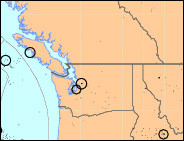 This isn't as morbid a preoccupation as it might seem; considering where I live, I probably take as little interest in the subject as one responsibly can take. In all the time I've lived on the west coast, the only earthquake I've actually been in were two very minor ones in Seattle between 1994 and 1996. During the first one, I was watching TV and my cats were chasing each other around the living room. When I felt the couch shake I thought it was my cats wrestling behind me so I whacked the seat cushion to get them to stop, then I spotted them on the other side of the room, crouching and looking totally freaked out. That was it — no aftershocks, nothing falling off shelves — just a briefly disorienting WTF moment that stretched on for hours in instant replays over the phone and on the local news.
This isn't as morbid a preoccupation as it might seem; considering where I live, I probably take as little interest in the subject as one responsibly can take. In all the time I've lived on the west coast, the only earthquake I've actually been in were two very minor ones in Seattle between 1994 and 1996. During the first one, I was watching TV and my cats were chasing each other around the living room. When I felt the couch shake I thought it was my cats wrestling behind me so I whacked the seat cushion to get them to stop, then I spotted them on the other side of the room, crouching and looking totally freaked out. That was it — no aftershocks, nothing falling off shelves — just a briefly disorienting WTF moment that stretched on for hours in instant replays over the phone and on the local news.
The other one happened a few months later when I was working in a hotel restaurant downtown. I had just come out on the floor to greet my new table, two ladies visiting from the midwest whose voices were clearly audible all the way back in the kitchen as they told the tale of their breathless escape from the elevator mere moments ago. They were on their way down when they felt the elevator lurch — they reenacted this in unison — then the doors opened, they spilled out into the lobby and asked everyone if there had been an earthquake. Throughout their story, my manager, a delightfully two-faced drama queen who had just turned 21 a few months before me, had been listening and nodding his head indulgently but, as I approached, I could see a single eyebrow inching up towards his hairline. So obvious was this to me that he might as well have been doing the universal sign for "crazy" with both hands instead of calmly filling their water glasses and taking their drink order.
I gave them the benefit of the doubt — surely something had happened in the elevator — but, as I approached the table minutes later with appetizers in hand, I could see their table shaking from side to side, the marble thudding loudly against the wall. I paused on the single step to the dining area and looked at them skeptically as if to say, okay ladies, that's enough out of you, but their hands were above the table and I could tell from the looks on their faces that they weren't screwing around. I cautiously approached and set their plates down as gently as possible. I couldn't tell if the table or I was still shaking. We were all still talking about it when the bar manager stuck his head in the door to make sure nothing was broken and told us there had indeed been a mild earthquake and one aftershock.
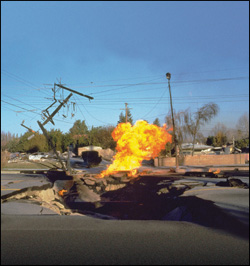 [Broken gas line on Balboa Boulevard after the 1994 Northridge earthquake near LA (photo by M. Rymer).]
[Broken gas line on Balboa Boulevard after the 1994 Northridge earthquake near LA (photo by M. Rymer).]
Now Mr. Pink is another story. Less than a year after he moved to LA, on the morning of October 1, 1987, he was shaken out of bed by a magnitude 5.9 earthquake. The epicenter was a suburb called Whittier, just a few miles from where he lived. Eight people were killed, parking garages and lowrise apartments like that one on Melrose Place collapsed like wedding cakes. Three days later, an aftershock of 5.3 killed another person and damaged even more property. By the time the magnitude 6.7 Northridge earthquake hit the outskirts of LA in January 1994, he had already moved to Vancouver but he vividly remembers calling everyone he knew down there to make sure his friends were alright.
 [Highway 880 after the Loma Prieta earthquake on October 17, 1989 at 5:04 pm]
[Highway 880 after the Loma Prieta earthquake on October 17, 1989 at 5:04 pm]
Mr. Pink was also in LA on October 17, 1989 watching the World Series on TV when a magnitude 7.1 earthquake hit near San Francisco, where the game was taking place — as a result, the Loma Prieta earthquake was the first earthquake in US history to be broadcast live on television. Of the 63 people who died, 42 of them were killed on the Cypress Street Viaduct when a 1.25 mile section of the double-decker freeway collapsed. Last month the city marked the 20th anniversary of the disaster, publishing photo galleries and articles like this one about Dr. James Betts, who performed emergency surgery on a boy trapped in a car under the wreckage of the fallen upper deck. The reporter recalls arriving at the scene:
"[W]hen I first got there in the early evening I remember also that I looked up and felt dizzy and sick, as though I were staring at a body that had been disemboweled. The ripped freeway had opened a great cross-section of gigantic construction innards that sprawled and jutted and smoked and hissed. Parts of cars were visible inside the striations of concrete and metal, but the whole arrangement made no sense; you couldn't understand what was roadway and what was broken piling, and on the ground were cars upside down and jerked over at weird angles between the fire trucks and improvised emergency equipment, and at one spot below the overpass a crowd of medical workers had gathered at the base of a long ladder that stretched right up into the mess overhead.
That — two stories above us, that is, inside the mess — was where James Betts, stretched out belly-down on a backboard to help keep his own weight from crushing his patient, was preparing to operate on the boy." — Cynthia Gorney, Oakland North News
You know, all this disaster rehashing makes me realize how lucky I am to have grown up before we had all these TV shows like "Mayday" and "Air Crash Investigations" that deconstruct and reenact plane crashes. I can enjoy them now (online of course) with all the guilty vicarious horror their creators intended, but only because I almost never fly anymore. Until I turned 18 I used to get on a plane four times a year, as regular as daylight savings time, and every time there was a high-profile plane crash (read "Americans killed"), I would experience this renewed, irrational fear of flying — well, not so much flying as taking off and landing — and turbulence.
After a lifetime of uneventful cross-country flights, there was one plane crash that did serious damage to my ability to rationalize statistics against what I saw on television (although I'll admit, that scene from Die Hard 2 was a close second).
 It happened on July 19, 1989 in Sioux City, Iowa and they played the footage over and over for days on all the news shows, but who could blame them? That grainy 20-second video was so perfectly horrific; just a glimpse of the DC-10 banking towards the runway, coming in too fast over the trees, disappearing behind a building, the amateur cameraman swinging around to capture the plane as it emerges a second later, its left wing engulfed in an enormous fireball, the camera shaking as the plane cartwheels grotesquely and begins to break apart, thick clouds of black smoke gushing from the mangled tail section as the fuselage finally comes to rest in a cornfield at the end of a charred trench of mangled tarmac.
It happened on July 19, 1989 in Sioux City, Iowa and they played the footage over and over for days on all the news shows, but who could blame them? That grainy 20-second video was so perfectly horrific; just a glimpse of the DC-10 banking towards the runway, coming in too fast over the trees, disappearing behind a building, the amateur cameraman swinging around to capture the plane as it emerges a second later, its left wing engulfed in an enormous fireball, the camera shaking as the plane cartwheels grotesquely and begins to break apart, thick clouds of black smoke gushing from the mangled tail section as the fuselage finally comes to rest in a cornfield at the end of a charred trench of mangled tarmac.
The entire story of United Airlines 232 is told by flight instructor Denny Fitch in an amazing interview with documentary king Errol Morris in an episode of his First Person series called "Leaving the Earth." His account is — perhaps ironically — one of the most life-affirming things I've ever seen.